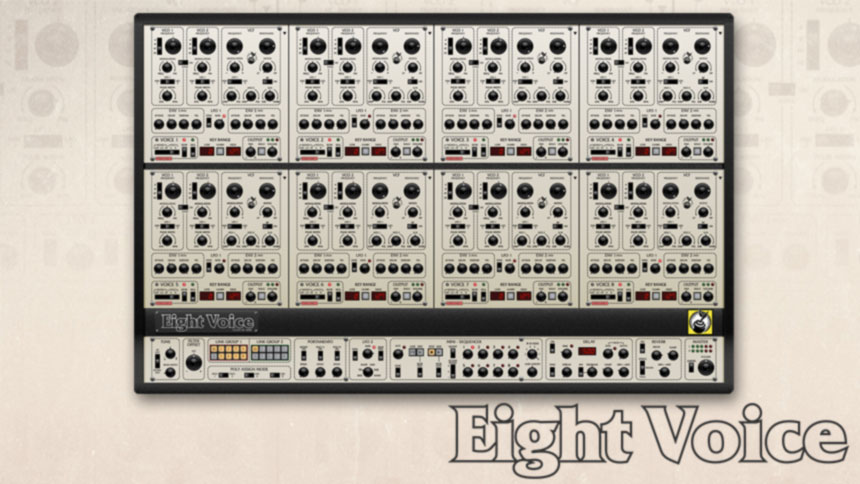
Cherry Audio’s Eight Voice is an emulation of the mighty Oberheim® Eight Voice synthesizer, originally unleashed in 1977. It began life in 1974 as a simple, keyboardless mono synth called the Synthesizer Expander Module, or “SEM.” The SEM module was intended as a companion to the Oberheim DS-2, one of the earliest digital sequencers. Oberheim soon realized they could interface a digitally scanned keyboard, mount the whole mess in a big box, and create polyphonic synthesizers, beginning with the Two Voice, followed by the Four Voice, and finally the beastly Eight Voice.
Though it was one of the first synthesizers to utilize a digitally scanned keyboard that assigned notes to independent synth voices, unlike later analog polysynths, it lacked computer control and parameter storage. This meant that each of its eight synthesizer voice modules contained individual controls for every parameter. If you wanted to adjust the filter resonance, for example, you’d need to change the resonance control on every one of the eight synthesizer voices, otherwise each note played would sound different. This allowed for varying timbres for different notes, a potentially musically useful and interesting effect, but not much fun if you wanted every note to sound the same.
The Eight Voice did include a crude programmer section with 16 patch storage slots, but instead of storing actual knob and switch values, it simply added offset voltages to the existing knob setting. In other words, a user would set the knobs to zero, and the programmer could “turn up” the knobs by adding a voltage value. Only a handful of parameters were “storable,” per se, and switch positions couldn't be stored. This made changing sounds during a live performance a dicey affair at best.
So why would anybody deal with this madness? If you needed a synthesizer that could play chords in the 70s, you had very limited options. To their credit, the early Oberheim synths sounded fantastic, and few other poly synths of the era could play individually articulated polyphonic notes (i.e. each note having its own separate filter/amplitude envelope). Once the computer-controlled Sequential Circuits Prophet-5 came along in 1978 with single knobs controlling common voice parameters and full digital patch storage, the heyday of Oberheim's Two, Four, and Eight Voice instrument instantly ended. Oberheim released the OB-X soon thereafter, which used microprocessor control to achieve similar functionality to the Prophet-5.
The Cherry Audio Eight Voice retains Eight Voice’s stupendous sound quality, but its unique Voice Link section lets users link the controls of voice modules, eliminating the need to individually set each module's controls when “homogenous” poly sounds are desired. Additionally, the tool bar "focus" buttons allow any section of Eight Voice to instantly "zoom in" to a much larger size, making editing much easier (especially on smaller displays).
Each module also contains easy to use Key Range zone selectors for endless layering and zoning possibilities. An expanded version of the Oberheim eight-step Mini Sequencer is also included, featuring switchable step gating, adjustable gate length, pitch quantization, and more. We’ve also thrown in a powerful mod delay, and a lush reverb section. All in all, we've done everything possible to transform the original instrument's daunting user interface into a fast, fun, and most of all, creative musical experience. You're gonna love it!
Technical Assistance
Cherry Audio's unique online store and automatic updating should make operation a smooth experience, but if you run into any issues or have questions, you can discuss issues online at the Cherry Audio forums at:
https://forums.cherryaudio.com/viewforum.php?f=45
... or you can communicate directly with one of our surly and grumpy, scratch that... outgoing and friendly tech support staff at:
https://cherryaudio.kayako.com/
Oberheim® and SEM are trademarks of Tom Oberheim. There is no association, affiliation or endorsement of Cherry Audio or its products by Tom Oberheim.